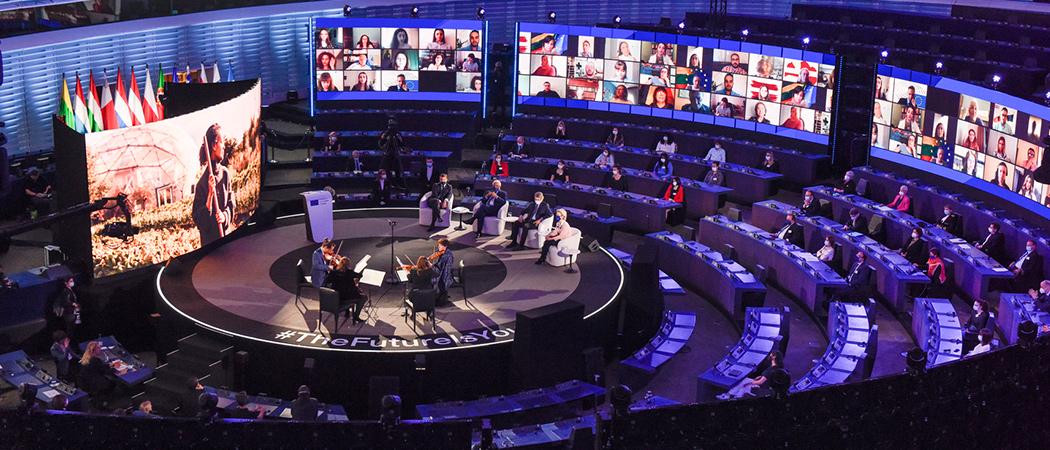The conference is inviting proposals on future reforms and is open to all, with citizens able to comment on 9 distinct topics. But research and innovation isn’t one of them

Research and innovation should be included on the agenda of the Conference on the Future of Europe, research and industry organisations say in a manifesto published on Wednesday.
The Conference is envisaged as a comprehensive reform process, but to the disappointment of many stakeholders, research and innovation are not among the nine topics on the conference agenda.
That means specific proposals for the future of R&I have to be submitted to the catch-all “other ideas” topic number 10.
The Commission, EU Council and the Parliament have committed to listen to Europeans and to follow up on the recommendations made once the ideas submitted online have been analysed and published.
By spring 2022, the Conference is expected to reach conclusions and provide guidance on the future of Europe.
The manifesto is intended to ensure that, “Actors in the conference know that research and innovation are key and need to be recognised within the conclusions of the conference,” said Mattia Cheracchi, head of the EU liaison office at the Italian Agency for European Research.
“The impression we and other stakeholders have, is that there is not enough attention on research and innovation,” said Massimo Busuoli, head of the Brussels office of the Norwegian University of Science and Technology, which is one of the manifesto signatories.
The signatory organisations have not come to an agreement on which policies or reforms they would back during the conference. Many of them have diverging views on which R&I policies are best suited for the EU. However, at the very least, the conference could be an opportunity to “raise ambitions” for the renewed European Research Area (ERA), said Ceracchi.
The Commission and Council of the EU are finalising an agreement on the steps needed to align R&D policies and investment levels across 27 member states, as part of the ERA renewal plans, including a commitment to boost national R&D expenditures to 3% of GDP. “There are different opinions from each organisation also on the investment targets,” Ceracchi said.
This has been a sore point with many European research leaders ever since the Conference of the Future process began. In his parting words, former president of the European Research Council Jean-Pierre Bourguignon said the conference should be used to state loudly that the future of Europe will depend on its performance in research and innovation. Bourguignon said the ERC was “taken aback” by the fact that the conference agenda does not mention research and innovation at all.
“The manifesto has created a cohesive group of organisations highlighting the importance of keeping R&I high on the agenda,” said Busuoli.
No concrete proposals on research
In their manifesto, research stakeholders refrain from explicitly listing concrete proposals for reforming EU research policies. For now, they are focusing on raising awareness on the contribution of research and innovation to a reformed EU. But it’s still unclear what that reform would look like, and if and when it will happen. “We do not know at the moment where this process will lead,” said Ceracchi.
It’s also unclear what the Conference on the Future of Europe will achieve. While leaders have agreed on how it will be run and who will govern it, the EU institutions disagree over its practical outcome. The European Parliament sees it as a good opportunity to reform the EU treaties, but member states have ruled out this option.
MEPs and stakeholders in the higher education sector have also argued the conference could be a good opportunity to update EU treaties and include explicit provisions to protect academic freedom, but they are facing a steep road ahead, with an overhaul of EU treaties strictly off the agenda.
Whatever the upshot is, research and innovation stakeholders are anxious to get their foot in the door. “If we are successful in this initiative, we can be better positioned in view of the conclusions,” the manifesto says.
Busuoli said universities should use the conference as a way to engage with citizens and “align our activities” with citizens’ expectations. “[We] are funded by the taxpayers and it is important that they are aware and can be part in the co-design and understand why research and innovation is important,” said Busuoli.
How does the conference work?
While the topic of education, culture, youth and sport in Europe is included, research and innovation are not. Other topics are climate change, health, digital transformation, economic growth, international relations, rule of law and democracy, and migration.
Anyone can put forward their own proposals on the website, which are then discussed in panels made up of randomly selected citizens.
The best ideas will then be debated in plenaries made up of 108 representatives from the Parliament, 54 from the Council, and three from the Commission. Representatives of EU institutions will be joined by another 108 citizens, 18 representatives of the Committee of the Regions, 18 representatives from the Economic and Social Committee, 12 elected representatives from local and regional authorities, and 20 representatives of “social partners” and civil society.
“The plenary basically needs to ensure that recommendations are debated without a predetermined outcome,” said Ceracchi.
So far, the conference has been gathering ideas from citizens on a multilingual online platform, but inputs to date are unimpressive, with only a few thousand ideas submitted from a total population of nearly 450 million.





 A unique international forum for public research organisations and companies to connect their external engagement with strategic interests around their R&D system.
A unique international forum for public research organisations and companies to connect their external engagement with strategic interests around their R&D system.